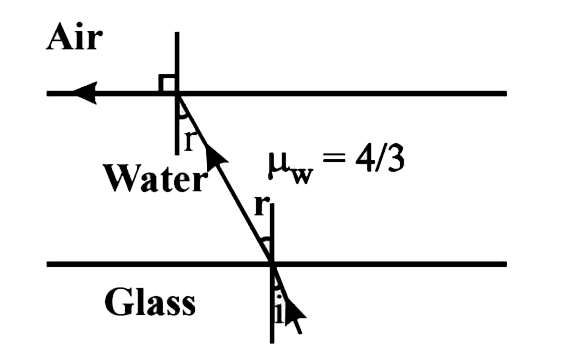A ray of light is incident at the glass-water interface at an angle I, it emerges fimally parallel to the surface of water, the the value of μg would be
 Solution in Gujrati
Solution in Gujrati
(4/3) sin i
1/sin i
4/3
1
The correct Answer is:B
Applying Snell's law (μsini = constant ) at 1 and 2 , we have μ1sinii1=μ2sini2
_E01_212_S01.png)
Here μ1=μglass,i1=I,μ2=μair=1andi2=90∘
∴μgsini=(1)(sin90∘)orμg=1sin i
Topper's Solved these Questions
- GEOMETRICAL OPTICSBOOK - ALLEN CHAPTER - GEOMETRICAL OPTICSEXERCISE - MCQ
5 Videos
- GEOMETRICAL OPTICSBOOK - ALLEN CHAPTER - GEOMETRICAL OPTICSEXERCISE - MATCHING
2 Videos
- GEOMETRICAL OPTICSBOOK - ALLEN CHAPTER - GEOMETRICAL OPTICSEXERCISE - EXERCISE-05 (A)
35 Videos
- CURRENT ELECTRICITYBOOK - ALLEN CHAPTER - CURRENT ELECTRICITYEXERCISE - EX.II
66 Videos
- GRAVITATIONBOOK - ALLEN CHAPTER - GRAVITATIONEXERCISE - EXERCISE 4
9 Videos
Similar Questions
A ray of light travelling in a transparent medium falls on a surface separating the medium from air at an angle of incidence of 45 degree. The ray undergoes total internal reflection. If n is the refractive index of the medium with respect to air, select the possible value (s) of n from the following:
View SolutionAn optical component and an object S placed along its optic axis are given in Column I . The distance between the object and the component can be varied. The properties of images are given in Column II . Match all the properties of images from Column II with appropriate components given in Column I.
_E01_239_Q01.png)
View SolutionIf two mirrors are kept at 60∘ to each other, then the number of images formed by them is ......
View SolutionIn the Bohr's model of hy drogen atom, the electron moves around the nucleus in a circular orbit of radius 5×10−11m. Its time period is 1.5×10−16s. The current associated with the electron motion is:-
View SolutionAssertion : The difference in the value of acceleration due to gravity at pole and equator is proportional to square of angular velocity of earth.
Reason : the value of acceleration due to gravity is minimum at the equator and maximum at the pole.
View SolutionA ray of light is incident at the glass-water interface at an angle I, it emerges fimally parallel to the surface of water, the the value of μg would be

View SolutionA ray of light travelling in glass (mu_g=3//2) is incident on a horizontal glass-air surface at the critical angle theta_C. If a thin layer of water (mu_w=4//3) is now poured on the glass-air surface. At what angle will the ray of light emerges into water at glass-water surface?
View SolutionA ray of light is incident at the glass-water interface at an angle i. It merges finally parallel to the surface of water. Then, the value of mu_(g) would be
View SolutionA ray of light is incident on the interface between water and glass at an angle i and refracted parallel to the water surface, then value of mu_(g) will be
View SolutionA ray of light is incident at the glass-water interface at an angle i it emerges finnaly parallel to the surface of water, then the value of mu_(g) would be
View Solutionएक प्रकाश - किरण काँच - जल अंतरापृष्ठ पर कोण I पर आपतित होती है तथा अंत में जल - वायु अंतरापृष्ठ के समान्तर निर्गत होती है | काँच का वायु के सापेक्ष अपवर्तनांक है

View SolutionA ray of light is incident at the glass-water interface at an angle i, it emerges finally parallel to the surface of water, then the value of pg would be

View SolutionA ray of light travelling in glass having refractive index _(a)mu_(g)=3//2 is incident at a critical angle C on the glass air interface. If a thin layer of water is poured on glass air interface, then what will be the angle of emergence of this ray in air when it emerges from water air inteface?
View SolutionA ray of light traveling in glass (mu_g = 3//2) is incident on a horizontal glass-air surface at the critical angle theta_c . If a thin layer of water (mu_w = 4//3) is now poured on the glass-air surface, at what angle will the ray of light emerges into water at glass-water surface?
View SolutionA ray of light is incident at the glass water interface at an angle I as shown in the figure. It emerges finally parallel to the surface of water, Then the value of mu_g would be
View SolutionA ray of light travelling in glass having refractive index mu_g = 3/2, is incident at a critical angle C on the glass- air interface. If a thin layer of water is poured on glass air interface, then what will be the angle of emergence of this ray in air when it emerges from water-air interface ?
View Solution
